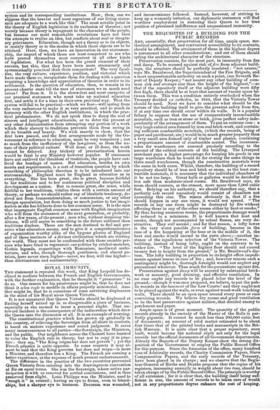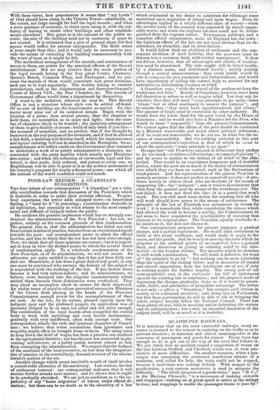THE REQUISITES OF A BUILDING FOR THE PUBLIC RECORDS
ARE, essentially, that preservation for all time, ample space, me- thodical arrangement, and convenient accessibility to its contents, should be afforded. The attainment of these in the highest degree is paramount to all other considerations ; and out of them should spring the architectural character of the structure. Preservation consists, for the most part, in immunity from fire and damp. To be secured against risk of:fire from adjacent build- ings, the structure should be perfectly insulated : "not nearer," says Mr. Braidwood, the Superintendent of the Fire Brigade, and a most unquestionable authority on such a point, (see Seventh Re- port of Deputy Keeper,) "not nearer any other building of com- mon risk and average size than the height of the highest,"—so that if the repository itself or the adjacent building were fifty feet high, there should be at least that amount of vacant space be- tween them. This was a condition entirely overlooked when the Treasury decided ex cathedra, in 1844, that the Victoria Tower should be used. Next we have to consider what should be the nature of the building itself to give the greatest safety from fire, if at any time one should occur within its walls. It is a popular fallacy to suppose that the use of comparatively incombustible materials, such as iron or stone or brick, gives perfect safety inde- pendently of the arrangement of them. To put an extreme case : a very large cubical area formed by iron and brick-work, and contain- ing sufficient combustible materials, (which the records, being of paper and parchment, are,) would be in much greaterjeopardy than a very small area formed only of timber and plaster, containing a proportionate amount of combustible matter. The insurance- rates for warehouses are assessed precisely according to the amount of the cubical contents of the building. The Liverpool merchant pays a higher percentage for keeping his goods in one large warehouse than he would do for storing the same things in three small warehouses, though the constructive materials were the same in both cases. Whilst, therefore, the building of a record repository should be of iron and brick or stone, as the least com- bustible materials, it is necessary that the individual chambers of it be not too large. Great halls or galleries would be decidedly less safe than moderate-sized rooms. Mr. Braidwood says, no room should contain, at the utmost, more space than 7,000 cubic feet. Relying on his authority, we should therefore say, that a perfectly safe record repository would consist of chambers not exceeding this size. The reason obviously is, that if a fire should happen in any one mom, it would not spread. "The records in any one room might be destroyed by fire without affecting those in any of the other rooms either by heat or smoke." By thus having numerous rooms, the proportionate damage would be reduced to a minimum. It is well known that heat and smoke, though not accompanied by actual flames, are very de- structive. They will ascend ; and for that reason, a lofty tower is the very worst possible form of building, because in the case of a fire happening at the base or in the middle of it, the heat and smoke would ascend to the parts above ;—another in- stance of the injudicious selection of the Victoria Tower. The building, instead of being lofty, ought on the contrary to be rather low. "The level of the highest floor should not exceed twenty feet in height from the ground," is Mr. Braidwood's dic- tum. The lofty building in proportion to its height offers impedi- ments against rescue in case of fire ; and, however remote such a contingency might be, thorough foresight would not neglect any precautions whatever. Thus much for the precautions against fire. Preservation against damp will be secured by substantial brick- work or masonry, good draining, and effective ventilation. In no case ought any records to be placed below the level of the ground,—though it was once proposed, we believe, to put the pub- lic records in the basement of the Law Courts ! and they ought not to be placed against the walls, or even against wood-work touching walls. There should be an open space around every press or case containing records. We believe dry rooms and good ventilation to be the best preservative against mildew, that decided enemy to parchment and paper. Ample space is of great moment. The quantity of the public records already in the custody of the Master of the Rolls is per- fectly gigantic. It cannot be much less than 200,000 cubic .feet of documents ; an amount of solid matter estimated to be about four times that of the printed books and manuscripts in the Bri- tish Museum. It is quite clear that a proper repository, once built, would become the national depot not only for the legal records but the official documents of all Government departments. Already the Reports of the Deputy Keeper show the strong dis- position of the Government to employ the Public Record Office for this purpose. Since the formation of the office, many hundred tons of Admiralty records, the Charity Commission Papers, Slave Compensation Papers, and the early records of the Treasury, have been placed in its charge ; and we observe that the Regis- trar-General of Births and Deaths proposes that the copies of his registers, increasing annually in weight about two tons, should be taken charge of by the Public Record Office. The principle is worthy of all extension ; for it is clear that, the building itself being suf- ficient in size, the amount of records to be taken care of would not in any proportionate degree enhance the cost of keeping. With these views, how preposterous it seems that "my Lords" of 1844 should have clung to the Victoria Tower—admittedly, at the outset, not large enough for half the legal records ; and what a mere pretence of economy, to insist upon using it, with the cer- tainty of having to create other buildings and other establish- ments elsewhererl But, great as is the amount of the public re- cords, the size of the building need not be enormous if space be not wasted. It is estimated that a plot of ground about 250 feet square would suffice for present emergencies. The Rolls estate is more ample than this; and it would only be necessary to pro- vide the means of extending the building commensurately with the want of room as it might be felt.
The methodical arrangement of the records, and convenience of access to them, are points for the practical officers of the Record establishment. But we may observe that the main portion of the legal records belong to the four great Courts, Chancery, Queen's Bench, Common Pleas, and Exchequer ; and we pre- sume the records of them would constitute four great divisions, each one to be kept separately. The residue belong to obsolete jurisdictions such as the Augmentation and Surveyor-General's Courts of Henry VIII., the Star Chamber, &c. The records of Government offices would form a department by themselves. A word to the architect, whoever he may be. This Record Office is not a structure whose style can be settled off-hand. Of no sort of building are the requirements so special. Its cha- racter must arise out of its minutest details. Begin with the location of a press ; then several presses; then the chamber to hold them, its necessities as to space and light ; then the num- ber of chambers likely to be wanted ; the judicious arrangement of them to give facility of access : build of only brick if you like— the meanest of materials, and we predict, that if due thought be bestowed on the real purpose of the structure, and if that be allowed a fair field, a building will develop itself, which for impressiveness and logical ordering will not be matched in the Metropolis. Its ac- complishment will reflect credit on the Government that ventured to undertake a work of so purely administrative a character, un- connected with the party motives which usually spur Ministries into action : and when the collection of our records, 'legal and his- torical, is thus made, duly ordered, and patent to every one, an Englishman will be able to point to it as the noblest monument of his country's progress for nearly a thousand years—one which all the nations of the world combined could not match.



























 Previous page
Previous page